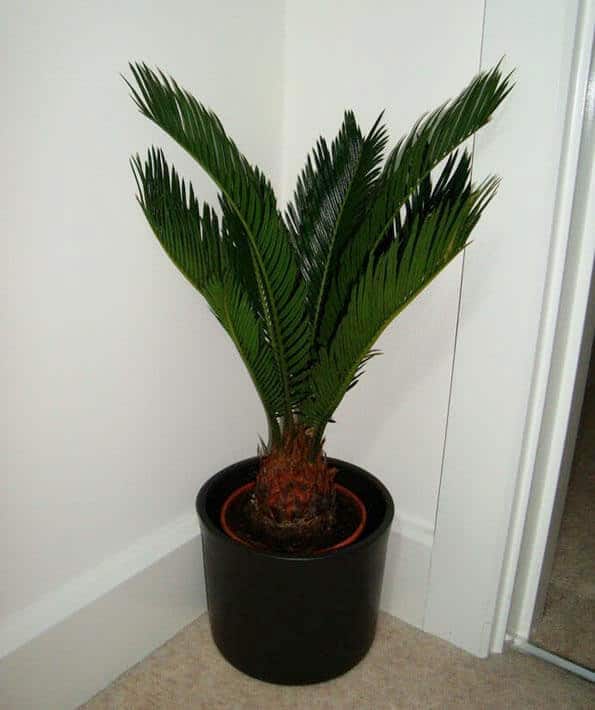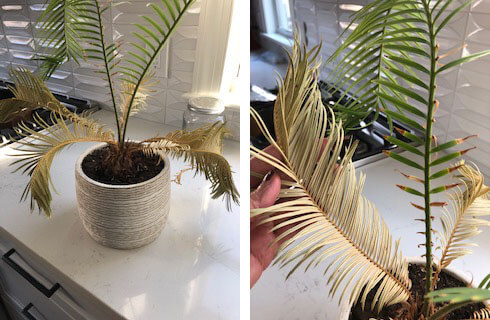Cycas Revoluta or the Sago Palm is a beautiful easy care houseplant. It's pretty unusually looking and its unique appearance makes for a talking point as well as a bold statement plant.
If it's treated well your Sago Palm will reach a modest size after 10 years or so. The leaves will rarely drop and because it only produces a handful of new leaves a year, it means it will take ages to outgrow wherever you've put it in your home.

Sago Palm plants are the definition of easy going. It's a drought-tolerant houseplant and can even cope with some low-light conditions. It won't grow at it's best if you treat it like this, but it can cope.
Despite its common name of "Sago Palm", it's not actually a palm because it's a Cycad (although the care requirements are similar).
The Sago Palm has a reputation of being a modern indoor houseplant (which it most definitely is). However in truth, as an outdoor plant, it's been around for million of years since the prehistoric times and so it's actually one of the oldest plants you can grow as a houseplant.
It's become more popular in the last decade as people have started to notice and appreciate the Sago Palm's easy going nature and very slow growth rate. It also doesn't need to be repotted too often and for allergy sufferers there is no pollen or flowers to deal with.
Be careful - the entirety of this plant is poisonous to animals and humans
Despite it's unfussy nature and harmless looking appearance the entirety of this plant is poisonous to animals and humans. A lot of houseplants have a slightly toxic and poisonous trait about them, but they either taste unpleasant so not enough of the plant is consumed to cause any damage or the toxicity isn't high enough to be a problem.
The Sago Palm is completely different. I rarely give this warning, but you should not have this plant in your home (or office) if your pet(s) eats houseplants or you have young curious children.
If that's not put you off, then good. It's an easy going, almost maintenance free indoor plant, that's a perfect fit for those hectic households which don't have much time for houseplant care or attention but when you just want something green (and very easy) around.

The semi glossy deep green leaves are quite tough and solid so resist damage well and maintain a rigid and symmetrical shape. - Photo Credit - Matheus Natan
They look tranquil and relaxing from a distance but stand their ground well against minor damage making it a mobile, can-do and hardy house guest. They make great container plants and look stunning in a variety of pots and planters.
There is only one species and variety of Sago Palm available to buy for the everyday shopper and that's Cycas Revoluta. Smaller plants are fairer in price and a very mature large specimen is going to set you back. However given how slowly they grow you may consider that it's worth splashing the cash if you want a large plant quickly.

Hi, I'm Tom!
If you're like me and enjoy the challenge of growing houseplants and getting them to thrive, then Ourhouseplants can help. This website shares my knowledge and years of growing plants and provides (hopefully) helpful advice on properly caring for your indoor plant friends.

The gold standard for most houseplants is bright light but no direct sun and that's true for the Sago Palms also. Too much light will cause damage to the leaves. Although it will not show negative consequences for quite some time if you give it too little light, poor light levels also need to be avoided in the long term.
Bright light with no direct sun should be your aim. Although moving a little outside of this guidance is unlikely to cause problems.
The trunk and fleshy leaves will store water, so Sago Palms do well with fairly long spells of no watering. However they're not true succulents so will perish if they're never watered.
The real danger for these houseplants is overwatering, long periods of soggy soil from poor drainage will encourage rot and that's what you need to be careful of. So water well and then don't do it again until the soil is almost completely dry. In Winter, when there is less light and temperatures are cooler you'll find you only need to water occasionally.
Sago's aren't fussy, so in most peoples homes whatever the humidity levels are surrounding your plant it should be fine.
Provide feed between Spring and mid-Summer using a general houseplant fertilizer and no more than once or twice a year. You can use normal strength as per the instructions.
These are subtropical plants which means they're perfectly adapted to average home temperatures and should be fine in almost any home. They just don't like it too cold though. So to prevent damage to the leaves and the trunk, no lower than 5°C (41°F) is recommended.
Because of how slow a Sago Palm grows, it takes forever for it to fill a pot and even then most are quite happy to stay crammed into their tiny homes for a few more years.
You only need to consider repotting if you're not getting any growth at all; the plant has become top heavy or wobbly in the existing container; or if it's been four or five years since it was last done.
Top Tip
A new frond will be soft and flexible, but once mature they become stiff. If you catch the wrong part of the leaf while handling, it can be painful. So wear gloves to protect against this.
Repot in early Spring, ideally using a free draining loam based compost. You can use other types of potting mixes if you have them to hand, but they do like organic matter, so avoid using very porous and free draining mixes.
Sometimes the parent plant produces offsets which you can remove and pot up as a separate plant. However this isn't a common occurrence for most grown as houseplants.
You can also sometimes propagate these plants through seeds if they produce any, but realistically this is rare as well. However if your Sago Palm does produce seed at some point, here is how to germinate them.
The Sago Palm growth rate is painfully slow. Some plants will only actually produce one single new leaf each year (although with great care it's normal to get at least couple).

A new leaf unfurling is a sight to see. They start off a lighter green before changing to the more familiar dark green leaves.
The most popular and current houseplant style for the indoor Sago Palm is smallish plants with a height of between a foot / 30cm and two foot / 60cm or so. You can of course get significantly bigger plants if you search or order them from specialists.
In general the plant you buy will stick at that height (or thereabouts) for a good many years. In perfect conditions after 100 years (yes you read that correctly) your plant might be 20 ft or more. Although they're very long lived plants, Sago Palm's living indoors are slow-growing plants.
The Sago Palm is a Cycad so will never produce flowers. Instead, you'll either have a male or female plant and will have corresponding reproductive parts. You can hand pollinate if you have a plant of each gender.
I've mentioned it at the start of the article, but I'm saying it again. The Sago Palm is toxic to cats and dogs and there is a high chance of serious problems or long term issues if any parts of this plant are consumed.
Do not have this plant in your home if you have inquisitive pets or young children. There are many other non toxic houseplants to choose from so get something else instead.
This is a very slow growing houseplant. Take it easy with anything you give your Sago, from light, water, heat and feed. You won't encourage it to grow more by increasing the quantity or frequency of these things and in fact if you do, it may cause more harm than good.
Moderate Light No harsh sun. No dark spots. Suitable plant for semi bright locations.
Occasional Watering Once a week in Summer and once every two or three weeks in Winter. Root rot can be a concern if you overdo it.
Temperature Typical household temperatures are perfect here.
Feeding Fertilize once or twice a year. Look to repot using a fresh potting mix every three to five years to keep the plant happy.
Sago Palm has yellow leaves.
Even with the best possible care yellowing on older leaves is normal (eventually the very old leaves are replaced) and not a concern if it's just one or two. Any other kind of yellowing needs to be investigated.

Although the plant likes growing in bright spots, too much direct sunlight can cause burn marks like this to appear. If your plant is outside, keep it in partial shade for protection.
In many cases, yellow leaves in a random spot on your plant like the one in the picture is a strong indication of some sort of burn caused by placing it in direct sunlight.
If the yellowing starts at the very tips or the very base of your plant then it's often a watering problem (normally too much).
It takes a very long time for Sago Palms to replace damaged leaves through new growth. So you need to be careful as any mistakes will take a long time to be replaced by a new leaf.
Sago Palm is hardly growing.
Even if you give the very best conditions and treat your plant perfectly you won't get much growth from year to year. Sago Palm's simply do not grow quickly at all. A few new leaves each year is what most owners will get and that's your lot.
Red Spider Mites.
Seeing as the Sago Palm isn't fussy about humidity it's possible you've chosen a low humidity area for your plant. This may encourage Red Spider Mites which love dry air. If you notice sticky webbing check out our Pest Article for tips in getting rid of this pest.
Scale Insects.
Fortunately the Sago Palm simply often won't be tasty enough to support a large Colony of invading Scale Insects, but you may still get a few visitors.
Sometimes a simple blemish on a leaf might be mistaken for a Scale Insect so check this first. If you're sure it's Scale simply pick / scrap it off, or use a methylated spirit to dissolve it away.
Dried out and dead looking leaves.
Whilst they can cope with drought for several weeks, if this goes on for too long some of the leaves will dry up and go over.
Try not to let your plant get to this state, but if it ever does then cut back the truly brown leaves and provide better care going forward. Over time new leaves will be produced that will replace those you've removed.

Sago Palm with dried out and brown leaves.
Sago palm is just generally "sickly".
Many houseplants enjoy a spell outside of the home or office from time to time. If you think your plant is looking a bit peaky, give it a few months holiday in the back garden / yard (obviously this holiday should take place during the warmer months of the year).
Direct sun should be avoided and if there are no drainage holes in the pot, take care rain doesn't cause it to become waterlogged. Don't forget to bring your plant back inside when Summer's over.
(Article / Gallery) Photo credit of the Sago looking down into it's heart Matheus Natan